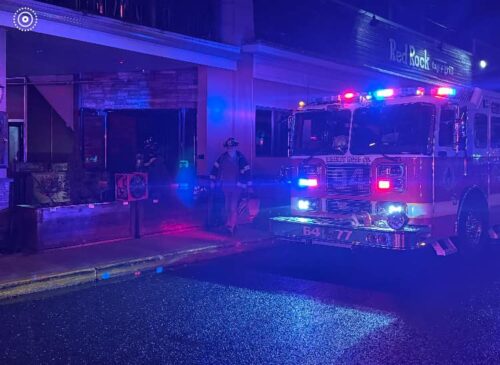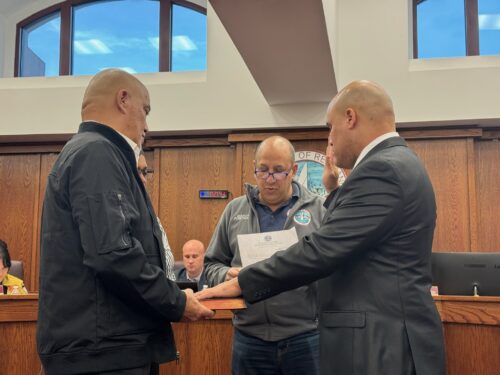 Charter school Principal Meredith Pennotti, flanked by trustee Roger Foss, left, and business administrator David Block, at Wednesday’s press conference. (Photo by John T. Ward. Click to enlarge)
Charter school Principal Meredith Pennotti, flanked by trustee Roger Foss, left, and business administrator David Block, at Wednesday’s press conference. (Photo by John T. Ward. Click to enlarge)
An enrollment lottery weighted to give economically disadvantaged kids a better shot at getting into the Red Bank Charter School should help address racial and ethnic disparities with the borough school district, charter school officials said Wednesday.
In a wide-ranging press conference held at the Oakland Street school, they also rebutted much of the criticism directed at their controversial expansion plan, which would double enrollment over three years, to 400 students. And they maintained that allegations of “segregation” resulting from charter school policies, and negative impacts on the local district’s finances, were aired and put to rest, more than a decade ago.
 The charter school leased space in this commercial building on Monmouth Street to accommodate its proposed expansion. Below, trustee Roger Foss. (Photo by John T. Ward. Click to enlarge)
The charter school leased space in this commercial building on Monmouth Street to accommodate its proposed expansion. Below, trustee Roger Foss. (Photo by John T. Ward. Click to enlarge)
After two months of heavy criticism, charter school Principal and Superintendent Meredith Pennotti invited reporters from redbankgreen and three other publications to to meet with her and two other officials: board of trustees vice president Roger Foss, an attorney who practices in Red Bank; and business administrator David Block.
Over the course of more than two hours at a conference room table, the trio addressed complaints about the proposal, which is now pending approval by New Jersey Education Commissioner David Hespe.
Among the highlights:
• They described the process by which the expansion plan came about, acknowledging that key to its inception was Hespe’s announcement, at a conference of charter school administrators last spring, that the state Department of Education would allow weighted lotteries for the first time since the state charter school law was enacted in 1995.
“That was the linchpin” that sparked the school’s expansion quest, Pennotti said. She added that Hespe’s encouragement that successful charters seek to expand or replicate themselves was also a factor.
In a weighted lottery, conducted by drawing, each economically disadvantaged child wishing to enroll would be assigned three bingo balls, versus two for the non-disadvantaged. That “could result in a 60-40 split” between economically disadvantaged and more fortunate new students in each of the three expansion years, said Pennotti,
While charter officials maintain the school’s demographics reflect the school-aged population of Red Bank, as required by law, they acknowledged the school doesn’t mirror the public school population, which is overwhelmingly Hispanic, as reflected at the district schools.
According to district Superintendent Jared Rumage, 80 percent of the district’s students are Hispanic, compared to 40 percent of the charter school’s, and white students make up just 7 percent of the district enrollment, compared to 52 percent of the charter school’s.
But Pennotti and Foss disputed the conclusion by panel appointed by Mayor Pasquale Menna to that Red Bank’s is the “most segregated” school system in New Jersey, and that the expansion plan would exacerbate the disparity. Pennotti said the disparity was an outcome of multiple factors, including a policy of sibling preference for wait-listed children, but that school officials do everything they can to recruit economically disadvantaged families to participate in the lottery.
“We know what our composition is,” Pennotti said, adding that the state prohibits charter schools from selecting students on the basis of race or ethnicity. “We want to be responsive to the population of Red Bank. [A weighted lottery] gives us a way to do it.”
Like the larger expansion plan, the selection system also must be approved by Hespe. So far, only one other charter school in the state, HOLA in Hoboken, has sought approval for the system.
• Pennotti and Foss said a firm plan to accommodate additional students had to be in place before the school could file an expansion application with the DOE, but securing additional space — which involved negotiations with a landlord and discussions with bankers — necessitated the plan be developed in secret.
Pennotti said the expansion idea only really took hold after the school, which had already leased a portion of 135 Monmouth Street for a STEM lab, learned that Prown’s Home Improvements, which occupied a large retail space in the building, was moving out, Pennotti said. That meant the building, which abuts the school’s Oakland Street campus, might be used not just for the STEM lab, but to accommodate pent-up demand for seats, as evidenced by the waiting list for enrollment.
“With that, coupled with the weighted lottery,” the idea of an expansion began to jell, she said.
• The charter school officials reiterated their contention that the school outshines the district academically. “We are required outperform” by state law, Pennotti said. “If we don’t, we’re put on probation or closed.”
Pennotti said the recently released PARCC test results demonstrate that the charter school eclipses the district schools, even taking into account the added challenges the district faces because a significant percent of its students haven’t learned English at home. She declined to immediately offer specifics, however, and said details would be included in a letter being sent to school parents Wednesday.(UPDATE: here’s the letter: RBCS_ParentNotice_PARCCScores)
• On finances, Block reiterated his contention, made at a meeting of charter school parents on January 21, that the school costs Red Bank taxpayers almost $3,000 less per student than the district — $9,284 versus $12,291.
In addition, by its very existence, the charter school brings almost $1.1 million more for the education of borough children than would otherwise be available, in the form of “special adjustment aid” from Trenton. Those funds are fowarded via the local district.
“We’re not asking for the money; the money follows the child,” Pennotti said. “The fact that the money in New Jersey has to flow through the local district is problematic, because it looks as if they get this money and then they have to give it away.”
Pennotti said the expansion “could even help to alleviate the pressure” on the district, where enrollment has soared to 1,400 students, from under 1,000 just a few years ago.
The district is “going to have to construct their budget to match up with the number of students they have” after the expansion, said Block.
Pennotti said charter school and district officials should “stand shoulder-to-shoulder” in pressing Trenton for more financial support to both.
“If they’re underfunded, we’re underfunded,” she said.
• Foss contended that we’ve been here before — specifically, in the borough board of education’s challenge to the charter school’s 2001 bid to expand by adding classes for kindergarten through third grade.
That challenge, based on arguments about segregation and financial impacts on the district, resulted in a 2004 appellate court ruling that Foss said closely examined many of the same issues raised in recent weeks. After the decision, the district board tried to further challenge the decision to the state Supreme Court, but was rebuffed, Foss said.
The appellate decision is germane, said Foss, “because it’s about this town, and this school. It’s important because it was such a thorough discussion of all the issues.”
“It’s all been said before, and it’s all been ruled on before,” Foss said.
Here’s the charter school’s application to the DOE: RBCS Amendment Request Dec 2015
And here’s audio of the full press conference; jump to 9:30 to skip the pre-Q&A chatter:























